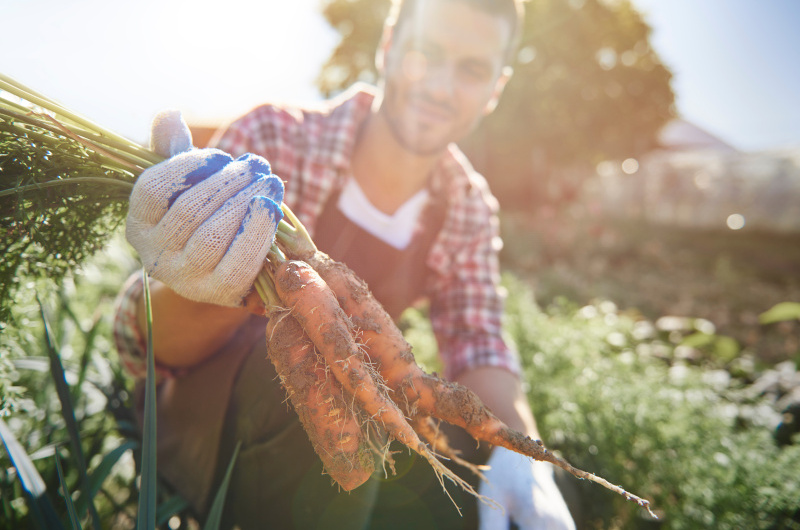How To Grow Carrots
Carrots (daucus carota) are a versatile and nutritious vegetable that can be easily grown in your own garden, providing you with a fresh and delicious addition to your meals. Whether you’re a seasoned gardener or a complete beginner, growing carrots is a rewarding experience that allows you to connect with nature and enjoy the fruits of your labour. In this article, we will guide you through the process of growing carrots in the UK, from choosing the right variety to harvesting your great crop.
Selecting the Right Carrot Variety:
Before you start planting, it’s essential to choose the right carrot variety for your UK garden. Consider factors such as the length of the growing season, soil type, and available space. There are numerous varieties of carrots, so it’s worth checking out the ranges offered by seed stockists such as garden centres. Popular UK carrot varieties include ‘Early Nantes’, probably the best of the early varieties, ‘Autumn King’ for late-season harvests, and ‘Chantenay’ for shorter, stubbier carrots. Some maincrop varieties of carrot can be sown from early spring onwards. We’d recommend trying ‘Little Finger’ for a really sweet, quick maturing variety with a taste vastly superior to supermarket carrots. There are even purple varieties for the adventurous grower.
Depending on your soil type, it’s a good idea to tailor the variety to suit the soil. If you have heavy soil, opt for shorter or round rooted varieties to avoid forking. If you have soft, sandy soil and good drainage opt for long carrots for the best crop. If you’re short of space, you can grow small round carrots in containers taking up little space, but be careful to avoid drying out in hot weather when growing in this way.
Preparing the Soil:
Carrots thrive in well-drained soil in a sunny spot which is free from stones and debris. Start by clearing the area of any weeds and rocks, and loosen the soil using a garden fork or tiller. Incorporate organic matter, such as compost or well-rotted manure, to improve soil fertility and provide essential nutrients for carrot growth. When adding manure, where possible, try and do this in the autum before growing root veg, as this gives the manure time to break down in the soil, reducing the chances of it causing forking of the roots.
Sowing Carrot Seeds:
Carrot seeds are tiny, so it’s important to handle them with care. Sow carrot seeds directly into the ground from late spring to early summer, once the soil has warmed up in a location which gets regular full sun. Create furrows or shallow trenches about 1 cm deep and space them around 15 cm apart. Sow the seeds thinly along the furrow and cover them gently with fine soil, ensuring they are evenly distributed.
Watering and Thinning:
Carrots need consistent moisture for proper growth, particularly during germination. Water the area lightly immediately after sowing and keep the soil consistently moist throughout the growing period. Avoid overwatering, as it can lead to rotting. Once the carrot seedlings reach a few inches in height, thin carrot seedlings out to provide adequate space for each carrot to develop. Aim for a final spacing of around 5 cm between plants. Compost any seedlings pulled out well away from the growing location in order to try and avoid attracting carrot fly, or use the baby carrots raw in salads.
Protecting Against Pests:
Carrots are susceptible to certain pests, such as carrot fly, which can cause significant damage. To protect your crop, consider using fine netting or horticultural fleece to create a physical barrier. Additionally, companion planting with aromatic herbs like rosemary or planting onions nearby can help deter carrot fly. Other common carrot pests include rabbits, who are attracted to young carrots like a magnet. If your garden or allotment is accessible to rabbits, we’d recommend that you cover plants with row covers, to avoid the disappointment of losing your entire crop.
Maintaining Healthy Growth:
Regular weeding is crucial to ensure that carrots receive adequate nutrients and water without competition from other plants. Gently hand-pull weeds to avoid damaging the delicate carrot roots. Applying a layer of mulch around the plants can help retain moisture, suppress weed growth, and keep the soil cool.
Harvesting Your Carrots:
Carrots are usually ready for harvest approximately 12 to 16 weeks after sowing, depending on the variety. As the foliage begins to yellow and the carrot shoulders appear near the soil surface, it’s a good indication that they are ready for picking. Gently loosen the soil around the carrots with a fork and lift them carefully to avoid damaging the roots. Enjoy the satisfaction of pulling up your first homegrown carrots! When it comes to eating, fresh carrots are bursting with flavour, so worth experimenting with, rather than just boiling. We love them grated in stir fries, mixed with cabbage and fermented into sauerkraut, or mashed with swede in winter.



